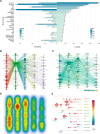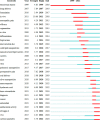Trends and Hotspots in Nanomedicine Applications for Pain: A Bibliometric Analysis from 1999 to 2024
- PMID: 39989766
- PMCID: PMC11840773
- DOI: 10.1021/acsomega.4c10893
Trends and Hotspots in Nanomedicine Applications for Pain: A Bibliometric Analysis from 1999 to 2024
Abstract
Background: Pain, especially chronic pain, is a leading cause of individuals seeking medical attention and presents a significant public health challenge due to its widespread prevalence and associated healthcare costs. Nanomedicine has shown considerable potential in pain management research. However, there is a lack of comprehensive bibliometric and trend analyses that explore the current status, research hotspots, and future directions of nanomedicine applications in pain. Methods: To fill this gap, we analyzed English language publications related to nanomedicine and pain from the Web of Science Core Collection, spanning the period from January 1, 1999, to May 24, 2024. The analysis focused on publication trends, contributions by countries/regions, institutions, journals, research categories, prominent authors, key references, and keywords. Results: A total of 2370 papers were included. China leads in the number of published papers (785, 33.12%) and hosts numerous high-output institutions and funding agencies, followed by the USA. The International Journal of Pharmaceutics emerged as the leading journal in terms of publication volume. A clear interdisciplinary platform has been established between nanomedicine and the field of pain. "Nanoparticles" and "drug delivery" were identified as high-frequency keywords. The drug delivery systems for pain treatment were considered the main research hotspots, particularly for chronic pain. The keyword citation bursts indicate that the pain of biomarker monitoring is a future trend. Conclusions: The application of nanomedicine in pain has advanced rapidly. Increased funding and international collaboration are necessary with future potential to expand from pain treatment to monitoring and diagnosis.
© 2025 The Authors. Published by American Chemical Society.
Conflict of interest statement
The authors declare no competing financial interest.
Figures








Similar articles
-
Global research trends of nanotechnology for pain management.Front Bioeng Biotechnol. 2023 Aug 28;11:1249667. doi: 10.3389/fbioe.2023.1249667. eCollection 2023. Front Bioeng Biotechnol. 2023. PMID: 37701493 Free PMC article.
-
Analysis of nanomedicine applications for inflammatory bowel disease: structural and temporal dynamics, research hotspots, and emerging trends.Front Pharmacol. 2025 Jan 8;15:1523052. doi: 10.3389/fphar.2024.1523052. eCollection 2024. Front Pharmacol. 2025. PMID: 39845796 Free PMC article.
-
[Visual analysis of the current research status and hotspots of electric burns at home and abroad].Zhonghua Shao Shang Yu Chuang Mian Xiu Fu Za Zhi. 2023 Oct 20;39(10):977-984. doi: 10.3760/cma.j.cn501225-20230511-00167. Zhonghua Shao Shang Yu Chuang Mian Xiu Fu Za Zhi. 2023. PMID: 37899564 Free PMC article. Chinese.
-
Trends in nanomedicine for colorectal cancer treatment: Bibliometric and visualization analysis (2010-2024).World J Gastrointest Oncol. 2025 Apr 15;17(4):102438. doi: 10.4251/wjgo.v17.i4.102438. World J Gastrointest Oncol. 2025. PMID: 40235868 Free PMC article.
-
Mapping the intellectual structure and emerging trends on nanomaterials in colorectal cancer: a bibliometric analysis from 2003 to 2024.Front Oncol. 2025 Jan 8;14:1514581. doi: 10.3389/fonc.2024.1514581. eCollection 2024. Front Oncol. 2025. PMID: 39845318 Free PMC article.
References
-
- Raja S. N.; Carr D. B.; Cohen M.; Finnerup N. B.; Flor H.; Gibson S.; Keefe F. J.; Mogil J. S.; Ringkamp M.; Sluka K. A.; et al. The revised International Association for the Study of Pain definition of pain: concepts, challenges, and compromises. Pain 2020, 161 (9), 1976–1982. 10.1097/j.pain.0000000000001939. - DOI - PMC - PubMed
LinkOut - more resources
Full Text Sources
Miscellaneous
